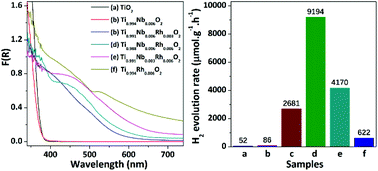The simultaneous realization of visible light response and high photocatalytic activity remains a challenging task for TiO2 despite extensive research. Herein, (Nb,Rh) codoping is adopted to extend the absorption band of anatase TiO2 into the visible-light region. Meanwhile, the dependence of the electronic structure, visible-light absorption, and photocatalytic performance on the dopant ratio as well as doping concentration is studied. Open shell t2g5 Rh(IV) and closed shell t2g6 Rh(III) coexist in Rh-doped TiO2, and the codoped Nb promotes a change in valence state from Rh(IV) to Rh(III). Rh(III) is the main active species in charge of the excellent photocatalytic performance, while Rh(IV) doping introduces electron/hole recombination centres. However, surprisingly, a trace of Rh(IV)-doping contributes to a decrease in electron transfer resistance and an increase in donor density, which help to improve photocatalytic performance. By virtue of the controlled content of Rh(III) and Rh(IV), Ti1−2xNbxRhxO2 exhibits a high hydrogen evolution rate of ∼9000 μmol g−1 h−1 in methanol solution, along with a remarkable photocurrent density of ∼9 μA cm−2 under visible-light irradiation, which are about 170 and 30 times higher than those of pristine TiO2 nanorods, respectively.
